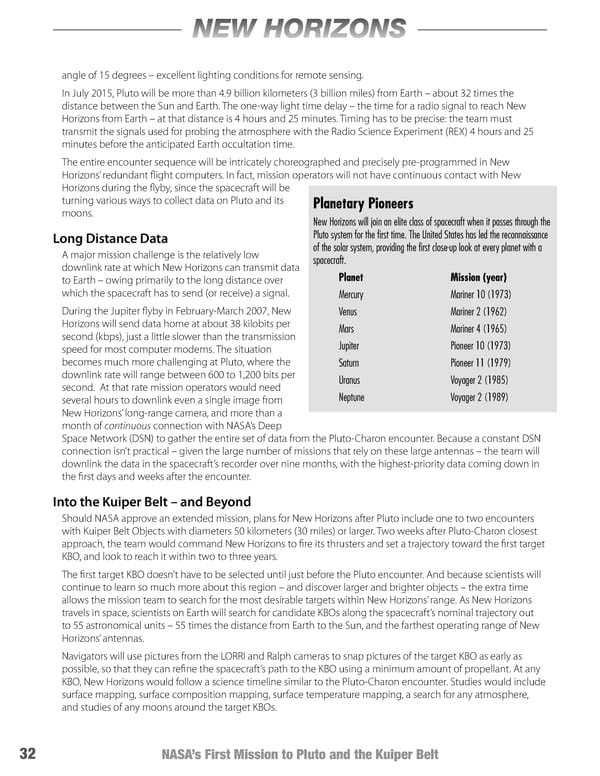NEW HORIZONS angle of 15 degrees – excellent lighting conditions for remote sensing. In July 2015, Pluto will be more than 4.9 billion kilometers (3 billion miles) from Earth – about 32 times the distance between the Sun and Earth. The one-way light time delay – the time for a radio signal to reach New Horizons from Earth – at that distance is 4 hours and 25 minutes. Timing has to be precise: the team must transmit the signals used for probing the atmosphere with the Radio Science Experiment (REX) 4 hours and 25 minutes before the anticipated Earth occultation time. The entire encounter sequence will be intricately choreographed and precisely pre-programmed in New Horizons’ redundant flight computers. In fact, mission operators will not have continuous contact with New Horizons during the flyby, since the spacecraft will be turning various ways to collect data on Pluto and its Planetary Pioneers moons. New Horizons will join an elite class of spacecraft when it passes through the Long Distance Data Pluto system for the first time. The United States has led the reconnaissance A major mission challenge is the relatively low of the solar system, providing the first close-up look at every planet with a downlink rate at which New Horizons can transmit data spacecraft. to Earth – owing primarily to the long distance over Planet Mission (year) which the spacecraft has to send (or receive) a signal. Mercury Mariner 10 (1973) During the Jupiter flyby in February-March 2007, New Venus Mariner 2 (1962) Horizons will send data home at about 38 kilobits per Mars Mariner 4 (1965) second (kbps), just a little slower than the transmission Jupiter Pioneer 10 (1973) speed for most computer modems. The situation becomes much more challenging at Pluto, where the Saturn Pioneer 11 (1979) downlink rate will range between 600 to 1,200 bits per Uranus Voyager 2 (1985) second. At that rate mission operators would need several hours to downlink even a single image from Neptune Voyager 2 (1989) New Horizons’ long-range camera, and more than a month of continuous connection with NASA’s Deep Space Network (DSN) to gather the entire set of data from the Pluto-Charon encounter. Because a constant DSN connection isn’t practical – given the large number of missions that rely on these large antennas – the team will downlink the data in the spacecraft’s recorder over nine months, with the highest-priority data coming down in the first days and weeks after the encounter. Into the Kuiper Belt – and Beyond Should NASA approve an extended mission, plans for New Horizons after Pluto include one to two encounters with Kuiper Belt Objects with diameters 50 kilometers (30 miles) or larger. Two weeks after Pluto-Charon closest approach, the team would command New Horizons to fire its thrusters and set a trajectory toward the first target KBO, and look to reach it within two to three years. The first target KBO doesn’t have to be selected until just before the Pluto encounter. And because scientists will continue to learn so much more about this region – and discover larger and brighter objects – the extra time allows the mission team to search for the most desirable targets within New Horizons’ range. As New Horizons travels in space, scientists on Earth will search for candidate KBOs along the spacecraft’s nominal trajectory out to 55 astronomical units – 55 times the distance from Earth to the Sun, and the farthest operating range of New Horizons’ antennas. Navigators will use pictures from the LORRI and Ralph cameras to snap pictures of the target KBO as early as possible, so that they can refine the spacecraft’s path to the KBO using a minimum amount of propellant. At any KBO, New Horizons would follow a science timeline similar to the Pluto-Charon encounter. Studies would include surface mapping, surface composition mapping, surface temperature mapping, a search for any atmosphere, and studies of any moons around the target KBOs. 32 NASA’s First Mission to Pluto and the Kuiper Belt
 New Horizons Page 41 Page 43
New Horizons Page 41 Page 43